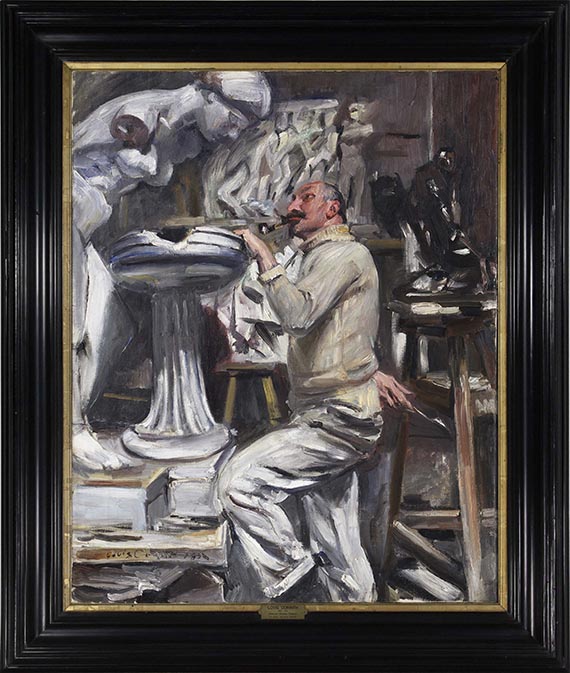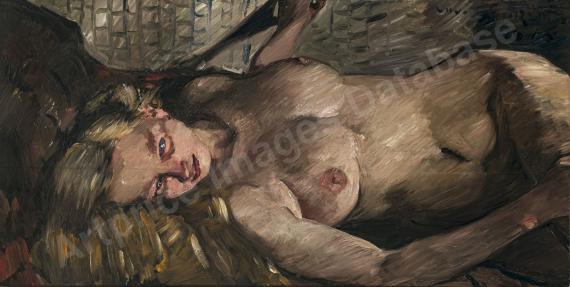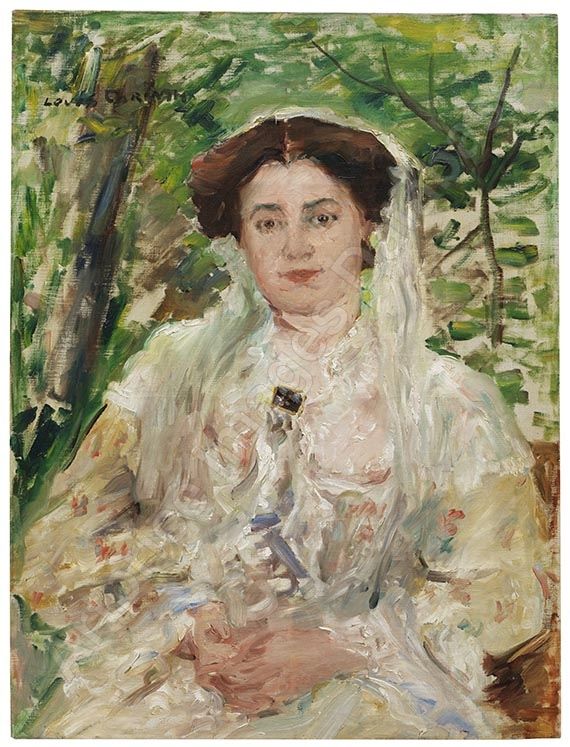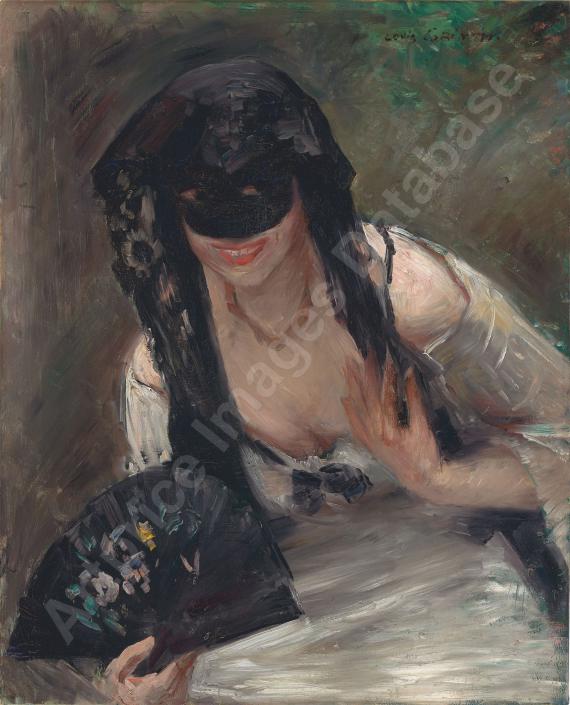Sale: 554 / Modern Art Day Sale, June 08. 2024 in Munich  Lot 124000201
Lot 124000201
 Lot 124000201
Lot 124000201
124000201
Lovis Corinth
Der Bildhauer (Portrait des Bildhauers Nikolaus Friedrich), 1912.
Oil on canvas
Estimate:
€ 60,000 - 80,000
$ 64,200 - 85,600
Information on buyer's premium, taxation and resale right compensation will be available four weeks before the auction.
Der Bildhauer (Portrait des Bildhauers Nikolaus Friedrich). 1912.
Oil on canvas.
Signed and dated in lower left of the image. 101 x 80 cm (39.7 x 31.4 in). [JS].
• Masterfully staged spontaneity: a snapshot-like presentation of a modern artist.
• Both the present "Der Bildhauer", as well as Corinth's famous self-portraits are painted with great clarity and concentration.
• A fascinating symbiosis of tradition and modernity, allusions to Pygmalion and the painterly anticipation of later photographic self-portraits.
• In 1913, exhibited at the Berlin Secession and the Ernst Arnold Gallery, Dresden, subsequently in the important exhibition "Modern German Art" at New Burlington Gallery, London.
• Important provenance: from the collection of the Corinth expert Dr. Alfred Ganz, Lucerne, and later part of the collection of the Busch-Reisinger Museum, Harvard/USA.
PROVENANCE: Dr. Alfred Ganz Collection, Lucerne (until at least 1955).
Art dealer Bühler, Munich.
Galerie Meissner, Zürich.
Schoeneman Galeries, New York (with the stamp on the reverse).
T. S. Morton Collection, presumably USA (acquired in 1970, Sotheby's July 1, 1970).
Busch-Reisinger Museum, Harvard University, Cambridge, Mass., USA. (presumably until around 1990).
Tate Gallery, London (with the label on the stretcher, inscribed "possible purchase" by hand).
Private collection Germany.
Private collection Northern Germany (since 2006, Lempertz, Cologne, June 3, 2006, lot 651).
EXHIBITION: Kollektionen von Lovis Corinth, Kunstsalon Pual Cassirer, Berlin, February 20 - March 14, 1906, no. 11.
Hagenbund XXI. exhibition, Vienna, December 7, 1906 - January 20, 1907, no. 119.
26th exhibition of the Berlin Secession, Berlin 1913, no. 207.
Galerie Ernst Arnold, Dresden 1913.
Berlin Secession, Berlin 1918, no. 107.
Kunsthaus Zürich, May/June 1924, no. 22.
Modern German Art, New Burlington Gallery, London, 1938, no. 51 (with the label on the reverse).
Eine Luzerner Privatsammlung, Kunstmuseum Luzern, 1947, no. 34.
Deutsche Impressionisten. Liebermann - Corinth - Slevogt, Schaffhausen, April-July 1955, no. 54 (with the label on the stretcher).
Lovis Corinth. Gedächtnisausstellung zur Feier des 100. Geburtstages, Volkswagenwerk Wolfsburg, May/June 1958 (with the label on the stretcher).
LITERATURE: Charlotte Berend-Corinth, Lovis Corinth. Die Gemälde. Catalogue raisonné, Munich 1992, no. 524 (illu. in black and white on p. 601).
- -
Sotheby's, London, auction on July 1, 1970, lot 101 (illu.).
Lempertz, Cologne, auction on June 3, 2006, lot 651 (illu.).
Oil on canvas.
Signed and dated in lower left of the image. 101 x 80 cm (39.7 x 31.4 in). [JS].
• Masterfully staged spontaneity: a snapshot-like presentation of a modern artist.
• Both the present "Der Bildhauer", as well as Corinth's famous self-portraits are painted with great clarity and concentration.
• A fascinating symbiosis of tradition and modernity, allusions to Pygmalion and the painterly anticipation of later photographic self-portraits.
• In 1913, exhibited at the Berlin Secession and the Ernst Arnold Gallery, Dresden, subsequently in the important exhibition "Modern German Art" at New Burlington Gallery, London.
• Important provenance: from the collection of the Corinth expert Dr. Alfred Ganz, Lucerne, and later part of the collection of the Busch-Reisinger Museum, Harvard/USA.
PROVENANCE: Dr. Alfred Ganz Collection, Lucerne (until at least 1955).
Art dealer Bühler, Munich.
Galerie Meissner, Zürich.
Schoeneman Galeries, New York (with the stamp on the reverse).
T. S. Morton Collection, presumably USA (acquired in 1970, Sotheby's July 1, 1970).
Busch-Reisinger Museum, Harvard University, Cambridge, Mass., USA. (presumably until around 1990).
Tate Gallery, London (with the label on the stretcher, inscribed "possible purchase" by hand).
Private collection Germany.
Private collection Northern Germany (since 2006, Lempertz, Cologne, June 3, 2006, lot 651).
EXHIBITION: Kollektionen von Lovis Corinth, Kunstsalon Pual Cassirer, Berlin, February 20 - March 14, 1906, no. 11.
Hagenbund XXI. exhibition, Vienna, December 7, 1906 - January 20, 1907, no. 119.
26th exhibition of the Berlin Secession, Berlin 1913, no. 207.
Galerie Ernst Arnold, Dresden 1913.
Berlin Secession, Berlin 1918, no. 107.
Kunsthaus Zürich, May/June 1924, no. 22.
Modern German Art, New Burlington Gallery, London, 1938, no. 51 (with the label on the reverse).
Eine Luzerner Privatsammlung, Kunstmuseum Luzern, 1947, no. 34.
Deutsche Impressionisten. Liebermann - Corinth - Slevogt, Schaffhausen, April-July 1955, no. 54 (with the label on the stretcher).
Lovis Corinth. Gedächtnisausstellung zur Feier des 100. Geburtstages, Volkswagenwerk Wolfsburg, May/June 1958 (with the label on the stretcher).
LITERATURE: Charlotte Berend-Corinth, Lovis Corinth. Die Gemälde. Catalogue raisonné, Munich 1992, no. 524 (illu. in black and white on p. 601).
- -
Sotheby's, London, auction on July 1, 1970, lot 101 (illu.).
Lempertz, Cologne, auction on June 3, 2006, lot 651 (illu.).
While Corinth's historical paintings, floral still lifes and landscapes still fascinate us today with their energetic and boisterous style, their powerful compositions and the shimmering colors, his painterly view of the artist, and primarily of himself, is characterized by a fascinating clarity and precision. Throughout his oeuvre, Corinth created numerous self-portraits in which he not only explored himself, but also the existence of the artist in general. One of his best-known self-portraits most certainly is "Self-Portrait with Skeleton" from 1896 (Lenbachhaus Munich). A work which, when viewed from a certain distance, shows a reduction and clarity that hints at New Objectivity. In the portrait, Corinth placed his massive figure directly next to the study skeleton in his studio in the manner of a double portrait.
When Corinth took over the presidency of the Berlin Secession from Max Liebermann in 1911, he was at the pinnacle of his career. However, in the same year, Corinth suffered a stroke, which not only resulted in partial paralysis, but would also enhance the strength and expressiveness of his painting. It was the famous history painting "The Blinded Samson", today in the collection of the Nationalgalerie Berlin, with which Corinth returned with a bang in 1912. It shows the shackled Samson with a blood-soaked cloth in front of his eyes and his arms in chains, groping his way forward against all pain and with all his remaining strength. The artist's own agony inspired his choice of a theme from the Old Testament; of which earlier examples can be found in Renaissance and Baroque painting.
In the same year, Corinth also painted this portrait of the Berlin sculptor Nikolaus Friedrich. With its airy manner and fascinating clarity, it perfectly lines up with his famous self-portraits from this period: the "Self-Portrait with Panama Hat" (Kunstmuseum Lucerne), also dated 1912, and the "Self-Portrait with Tyrolean Hat" (1913, Museum Folkwang, Essen). However, unlike Corinth, Friedrich is not a painter but a sculptor, accordingly, it is not enough to identify the activity solely through the attribute of a brush.
Corinth shows Friedrich, who would die at the age of 48 just two years after the portrait was made, in a casual, modern pose with a chisel or file in his right hand and a pipe loosely in the corner of his mouth engaged in a dialog with one of his creations, a female nude sculpture. This motif also demonstrates Corinth's masterful play with ancient mythology, in this case the Pygmalion story based on Ovid's Metamorphoses. According to ancient tradition, the famous sculptor Pygmalion fell in love with a female statue he had created, and which then came to life. In Corinth's work, however, the sculptor in white pants and a beige sweater blends in with the sculptural work surrounding him in his studio. Corinth staged him with a modern nonchalance and a spontaneity that seems completely new, both in contrast to the long iconographic tradition of Pygmalion depictions and in comparison to other contemporary artist portraits. In keeping with previous pictorial tradition, Friedrich is not depicted in a suit and has not turned his gaze towards the viewer; moreover, he is standing in his studio, leaning loosely over one leg, smoking and looking as if he was spontaneously captured in a photograph. In this modern artist portrait, Corinth seems to have anticipated the photographic portrayal of the artist that would be perfected in the second half of the century, starting with Auguste Rodin and, above all, by Pablo Picasso. [JS]
When Corinth took over the presidency of the Berlin Secession from Max Liebermann in 1911, he was at the pinnacle of his career. However, in the same year, Corinth suffered a stroke, which not only resulted in partial paralysis, but would also enhance the strength and expressiveness of his painting. It was the famous history painting "The Blinded Samson", today in the collection of the Nationalgalerie Berlin, with which Corinth returned with a bang in 1912. It shows the shackled Samson with a blood-soaked cloth in front of his eyes and his arms in chains, groping his way forward against all pain and with all his remaining strength. The artist's own agony inspired his choice of a theme from the Old Testament; of which earlier examples can be found in Renaissance and Baroque painting.
In the same year, Corinth also painted this portrait of the Berlin sculptor Nikolaus Friedrich. With its airy manner and fascinating clarity, it perfectly lines up with his famous self-portraits from this period: the "Self-Portrait with Panama Hat" (Kunstmuseum Lucerne), also dated 1912, and the "Self-Portrait with Tyrolean Hat" (1913, Museum Folkwang, Essen). However, unlike Corinth, Friedrich is not a painter but a sculptor, accordingly, it is not enough to identify the activity solely through the attribute of a brush.
Corinth shows Friedrich, who would die at the age of 48 just two years after the portrait was made, in a casual, modern pose with a chisel or file in his right hand and a pipe loosely in the corner of his mouth engaged in a dialog with one of his creations, a female nude sculpture. This motif also demonstrates Corinth's masterful play with ancient mythology, in this case the Pygmalion story based on Ovid's Metamorphoses. According to ancient tradition, the famous sculptor Pygmalion fell in love with a female statue he had created, and which then came to life. In Corinth's work, however, the sculptor in white pants and a beige sweater blends in with the sculptural work surrounding him in his studio. Corinth staged him with a modern nonchalance and a spontaneity that seems completely new, both in contrast to the long iconographic tradition of Pygmalion depictions and in comparison to other contemporary artist portraits. In keeping with previous pictorial tradition, Friedrich is not depicted in a suit and has not turned his gaze towards the viewer; moreover, he is standing in his studio, leaning loosely over one leg, smoking and looking as if he was spontaneously captured in a photograph. In this modern artist portrait, Corinth seems to have anticipated the photographic portrayal of the artist that would be perfected in the second half of the century, starting with Auguste Rodin and, above all, by Pablo Picasso. [JS]
124000201
Lovis Corinth
Der Bildhauer (Portrait des Bildhauers Nikolaus Friedrich), 1912.
Oil on canvas
Estimate:
€ 60,000 - 80,000
$ 64,200 - 85,600
Information on buyer's premium, taxation and resale right compensation will be available four weeks before the auction.









